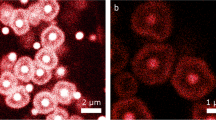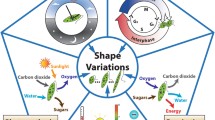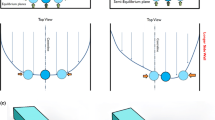Abstract
An inherent problem with microfluidic filters is the tendency to clog, especially when applied to cells due to their geometrical complexity, deformability, and tendency to adhere to surfaces. In this work, we handle live algal cells of high complexity without signs of clogging, achieved by exploiting hydrodynamic interactions around trilobite-shaped filtration units. To characterize the influence of cell complexity on the separation and concentration mechanisms, we compare the hydrodynamic interactions to those of synthetic, rigid microparticles. We discover that simple rolling along the filter structures, which prevents clogging for particles, cannot be applied to cells. Instead, we find that inertial effects must be employed to minimize the filter interactions and that this modification leads to only a minor reduction in device performance.







Similar content being viewed by others
References
Al-Faqheri W, Thio THG, Qasaimeh MA, Dietzel A, Madou M, Al-Halhouli A (2017) Particle/cell separation on microfluidic platforms based on centrifugation effect: a review. Microfluid Nanofluidics 21(6):102. https://doi.org/10.1007/s10404-017-1933-4
Babel S, Takizawa S (2010) Microfiltration membrane fouling and cake behavior during algal filtration. Desalination 261(1):46–51. https://doi.org/10.1016/j.desal.2010.05.038. http://www.sciencedirect.com/science/article/pii/S001191641000353X
Barros AI, Gonçalves AL, Simões M, Pires JC (2015) Harvesting techniques applied to microalgae: a review. Renew Sustain Energy Rev 41:1489–1500. https://doi.org/10.1016/j.rser.2014.09.037. http://www.sciencedirect.com/science/article/pii/S1364032114008107
Beech JP, Holm SH, Adolfsson K, Tegenfeldt JO (2012) Sorting cells by size, shape and deformability. Lab Chip 12:1048–1051. https://doi.org/10.1039/C2LC21083E
Chen CC, Chen YA, Liu YJ, Yao DJ (2014) A multilayer concentric filter device to diminish clogging for separation of particles and microalgae based on size. Lab Chip 14:1459–1468. https://doi.org/10.1039/C3LC51345A
Dijkshoorn J, Schutyser M, Wagterveld R, Schroën C, Boom R (2017) A comparison of microfiltration and inertia-based microfluidics for large scale suspension separation. Sep Purif Technol 173:86–92. https://doi.org/10.1016/j.seppur.2016.09.018. http://www.sciencedirect.com/science/article/pii/S1383586616317099
Dong T, Yang Z, Su Q, Tran NM, Egeland EB, Karlsen F, Zhang Y, Kapiris MJ, Jakobsen H (2011) Integratable non-clogging microconcentrator based on counter-flow principle for continuous enrichment of caski cells sample. Microfluid Nanofluidics 10(4):855–865. https://doi.org/10.1007/s10404-010-0717-x
Edvardsen B, Moy F, Paasche E (1990) Hemolytic activity in extracts of Chrysochromulina polylepis grown at different levels of selenite and phosphate. In: Granéli E, Sundstrøm B, Edler L, Anderson DM (eds) Toxic marine phytoplankton. Elsevier, New York, pp 284–289
Eppley R, Holmes R, Strickland J (1967) Sinking rates of marine phytoplankton measured with a fluorometer. J Exp Mar Biol Ecol 1:191–208
Ghadami S, Kowsari-Esfahan R, Saidi MS, Firoozbakhsh K (2017) Spiral microchannel with stair-like cross section for size-based particle separation. Microfluid Nanofluidics 21(7):115. https://doi.org/10.1007/s10404-017-1950-3
Godino N, Jorde F, Lawlor D, Jaeger M, Duschl C (2015) Purification of microalgae from bacterial contamination using a disposable inertia-based microfluidic device. J Micromech Microeng 25(8):084002. http://stacks.iop.org/0960-1317/25/i=8/a=084002
Holm SH, Beech JP, Barrett MP, Tegenfeldt JO (2011) Separation of parasites from human blood using deterministic lateral displacement. Lab Chip 11:1326–1332. https://doi.org/10.1039/C0LC00560F
Honsvall BK, Altin D, Robertson LJ (2016) Continuous harvesting of microalgae by new microfluidic technology for particle separation. Bioresour Technol 200:360–365. https://doi.org/10.1016/j.biortech.2015.10.046. http://www.sciencedirect.com/science/article/pii/S0960852415014492
Hood K, Kahkeshani S, Di Carlo D, Roper M (2016) Direct measurement of particle inertial migration in rectangular microchannels. Lab Chip 16:2840–2850. https://doi.org/10.1039/C6LC00314A
Huang LR, Cox EC, Austin RH, Sturm JC (2004) Continuous particle separation through deterministic lateral displacement. Science 304(5673):987–990. https://doi.org/10.1126/science.1094567. http://www.sciencemag.org/content/304/5673/987.abstract. http://www.sciencemag.org/content/304/5673/987.full.pdf
Jiang M, Mazzeo AD, Drazer G (2016) Centrifuge-based deterministic lateral displacement separation. Microfluid Nanofluidics 20(1):17. https://doi.org/10.1007/s10404-015-1686-x
Jiang Y, Yu Z, Huang X, Chen R, Chen W, Zeng Y, Xu C, Min H, Zheng N, Cheng X (2018) A multilayer lateral-flow microfluidic device for particle separation. Microfluid Nanofluidics 22(4):40. https://doi.org/10.1007/s10404-018-2053-5
Kamykowski D, Reed RE, Kirkpatrick GJ (1992) Comparison of sinking velocity, swimming velocity, rotation and path characteristics among six marine dinoflagellate species. Mar Biol 113(2):319–328. https://doi.org/10.1007/BF00347287
Kim HC, Park J, Cho Y, Park H, Han A, Cheng X (2009) Lateral-flow particle filtration and separation with multilayer microfluidic channels. J Vac Sci Technol B Microelectron Nanometer Struct Process Meas Phenom 27(6):3115–3119. https://doi.org/10.1116/1.3258155
Kotai J (1972) Instructions for preparation of modified nutrient solution Z8 for algae. Publication 8-11169. Norwegian Institute for Water Research, Blindern, Norway
Lenshof A, Laurell T (2010) Continuous separation of cells and particles in microfluidic systems. Chem Soc Rev 39:1203–1217. https://doi.org/10.1039/B915999C
Liu L, Loutherback K, Liao D, Yeater D, Lambert G, Estevez-Torres A, Sturm JC, Getzenberg RH, Austin RH (2010) A microfluidic device for continuous cancer cell culture and passage with hydrodynamic forces. Lab Chip 10:1807–1813. https://doi.org/10.1039/C003509B
Loutherback K, Chou KS, Newman J, Puchalla J, Austin RH, Sturm JC (2010) Improved performance of deterministic lateral displacement arrays with triangular posts. Microfluid Nanofluidics 9(6):1143–1149. https://doi.org/10.1007/s10404-010-0635-y
Marchalot J, Fouillet Y, Achard JL (2014) Multi-step microfluidic system for blood plasma separation: architecture and separation efficiency. Microfluid Nanofluidics 17(1):167–180. https://doi.org/10.1007/s10404-013-1296-4
Maria MS, Kumar BS, Chandra TS, Sen AK (2015) Development of a microfluidic device for cell concentration and blood cell-plasma separation. Biomed Microdevices 17(6):115. https://doi.org/10.1007/s10544-015-0017-z
Maria MS, Chandra TS, Sen AK (2017) Capillary flow-driven blood plasma separation and on-chip analyte detection in microfluidic devices. Microfluid Nanofluidics 21(4):72. https://doi.org/10.1007/s10404-017-1907-6
McGrath J, Jimenez M, Bridle H (2014) Deterministic lateral displacement for particle separation: a review. Lab Chip 14:4139–4158. https://doi.org/10.1039/C4LC00939H
Morijiri T, Yamada M, Hikida T, Seki M (2013) Microfluidic counterflow centrifugal elutriation system for sedimentation-based cell separation. Microfluid Nanofluidics 14(6):1049–1057. https://doi.org/10.1007/s10404-012-1113-5
Mossige EJ, Jensen A, Mielnik MM (2016) An experimental characterization of a tunable separation device. Microfluid Nanofluidics 20(12):160. https://doi.org/10.1007/s10404-016-1826-y
Mossige EJ, Jensen A, Mielnik MM (2018) Separation and concentration without clogging using a high-throughput tunable filter. Phys Rev Appl 9(054):007. https://doi.org/10.1103/PhysRevApplied.9.054007
Nam J, Shin Y, Tan JKS, Lim YB, Lim CT, Kim S (2016) High-throughput malaria parasite separation using a viscoelastic fluid for ultrasensitive pcr detection. Lab Chip 16:2086–2092. https://doi.org/10.1039/C6LC00162A
Olgae (2015) Comprehensive report on attractive algae product opportunities. http://www.oilgae.com/ref/report/non-fuel-algae-products.html
Prabhakar A, Kumar YVBV, Tripathi S, Agrawal A (2015) A novel, compact and efficient microchannel arrangement with multiple hydrodynamic effects for blood plasma separation. Microfluid Nanofluidics 18(5):995–1006. https://doi.org/10.1007/s10404-014-1488-6
Sajeesh P, Sen AK (2014) Particle separation and sorting in microfluidic devices: a review. Microfluid Nanofluidics 17(1):1–52. https://doi.org/10.1007/s10404-013-1291-9
Sugaya S, Yamada M, Seki M (2011) Observation of nonspherical particle behaviors for continuous shape-based separation using hydrodynamic filtration. Biomicrofluidics 5(2):024103. https://doi.org/10.1063/1.3580757
Warkiani ME, Tay AKP, Khoo BL, Xiaofeng X, Han J, Lim CT (2015) Malaria detection using inertial microfluidics. Lab Chip 15:1101–1109. https://doi.org/10.1039/C4LC01058B
Acknowledgements
This project was funded by Trilobite Microsystems A/S and The Research Council of Norway—Project number 232148. Support was also received from the Norwegian micro- and nanofabrication Facility (NORFAB) infrastructure project. All measurements were conducted at the Hydrolab at the Department of Mathematics at the University of Oslo in Norway. Thanks to SINTEF MiNaLab for manufacturing the microfluidic chips, to Vladyslava Hostyeva at NIVA and Bente Edvardsen at Department of Biosciences, UiO, for providing the algal cultures and the growth media. Also thanks to Rita Amundsen at Department of Biosciences, UiO, for overlooking the cultures. Thanks to our lab engineer Olav Gundersen for assistance with the pressure system and to Dag Dysthe at the Department of Physics (UiO) for lending us the camera, and thanks to Lailai Zhu in the Complex Fluids group at Princeton University for general feedback on the manuscript.
Author information
Authors and Affiliations
Corresponding author
Additional information
Publisher's Note
Springer Nature remains neutral with regard to jurisdictional claims in published maps and institutional affiliations.
Appendix
Appendix
1.1 Swimming behavior of algae
The marine dinoflagellates (M1,M2) have two flagella and have a helical swimming pattern. C. rostratiformis (F1) has two flagella, the forward with thin hairs is dragging the cell forward while erected. Figure 8 shows trajectories of the fastest swimmer used in this study, namely algae of P. reticulatum (M2). Figure 8a was obtained using a 4 \(\times\) objective and Fig. 8b was obtained using a 10 \(\times\) objective, and the exposure time of both images was 5 s. Based on the length of the streaks, the swimming speed is estimated to \(\sim 0.15\,\hbox {mm/s}\), which is negligible compared to the speed of cells in the flow field around the separation units (\(\sim 2\,\hbox {m/s}\)). Therefore, the swimming activity of cells used in this study does not influence the separation dynamics.
Long-exposure images of swimming cells in drops deposited onto a microscope slide: a trajectories of Protoceratium reticulatum (M2) in a 2 \(\upmu\)l drop viewed through a 4\(\times\) objective clearly shows the helical swimming pattern. The speed is negligible compared to the speed of a cell in the flow field around the separation units, and thus, the swimming does not influence the separation and concentration dynamics. b Long-exposure image of swimming Protoceratium reticulatum (M2) in a 110 \(\upmu\)l drop viewed through a 10\(\times\)-objective. Scale bar is \(400\,\upmu \hbox {m}\). Exposure time is 5 s
To be able to be stationary in the liquid without sinking or rising and to ease the task of swimming, the densities of the swimming organisms are only about \(5\%\) higher than that of water. The F2 cell is not a swimmer, but its disk-shaped body enables migration across streamlines, which allows it to be easily transported by whirls and currents over large distances. To fully exploit this transportation method, this cell is also nearly neutrally buoyant.
1.2 Algal cultures
The micro-algae used in this study were obtained from the Norwegian Culture Collection of Algae. The marine dinoflagellates P. minimum (strain UIO 089) and P. reticulatum (strain UIO 232) were isolated from the Oslofjorden, Skagerrak, Norway, in 1986 and 2001, respectively. The freshwater micro-algae M. truncata (strain NIVA-CHL 34) was isolated from River Storelva, Ringerike, in S. Norway in 1978 and C. rostratiformis (strain NIVA-3/81) from Lake Helgetjernet in 1981.
The marine cultures were grown in the algal medium IMR \(\frac{1}{2}\) medium (Eppley et al. 1967), supplemented with 10 nM selenium (Edvardsen et al. 1990) with salinity of 25 PSU. The freshwater algal strains were grown in the medium Z8 (Kotai 1972) or a modified Z8 medium. The media were sterilized by pasteurization at \(80\,^{\circ }\hbox {C}\) for 20 min. All four strains were grown at \(16\,^{\circ }\hbox {C}\) under fluorescence white light with an irradiance of approximately \(50\,\upmu \hbox {mol}\) photons/\(\hbox {m}^{2}/\hbox {s}\), and a 14h:10h light:dark cycle. They were grown as batch cultures in 5 l Erlenmeyer flasks and harvested in the exponential or beginning of stationary growth phase.
Rights and permissions
About this article
Cite this article
Mossige, E.J., Edvardsen, B., Jensen, A. et al. A tunable, microfluidic filter for clog-free concentration and separation of complex algal cells. Microfluid Nanofluid 23, 56 (2019). https://doi.org/10.1007/s10404-019-2209-y
Received:
Accepted:
Published:
DOI: https://doi.org/10.1007/s10404-019-2209-y





